AIBT Global: HLTWHS004 Manage Work Health & Safety - Workbook
VerifiedAdded on 2023/06/14
|53
|10591
|277
Homework Assignment
AI Summary
This document is a learner workbook solution for HLTWHS004, which focuses on managing work health and safety. It includes instructions for students, assessment tasks and requirements, competency outcomes, and processes for assessment appeals, special needs, and handling confidentiality and academic misconduct. The workbook features activities designed to reinforce learning, case studies from Safe Work Australia to illustrate real-world scenarios, and a knowledge activity to test comprehension. It also contains a student declaration form and guidelines for group work to ensure academic integrity. Desklib provides this and other solved assignments to aid students in their studies.
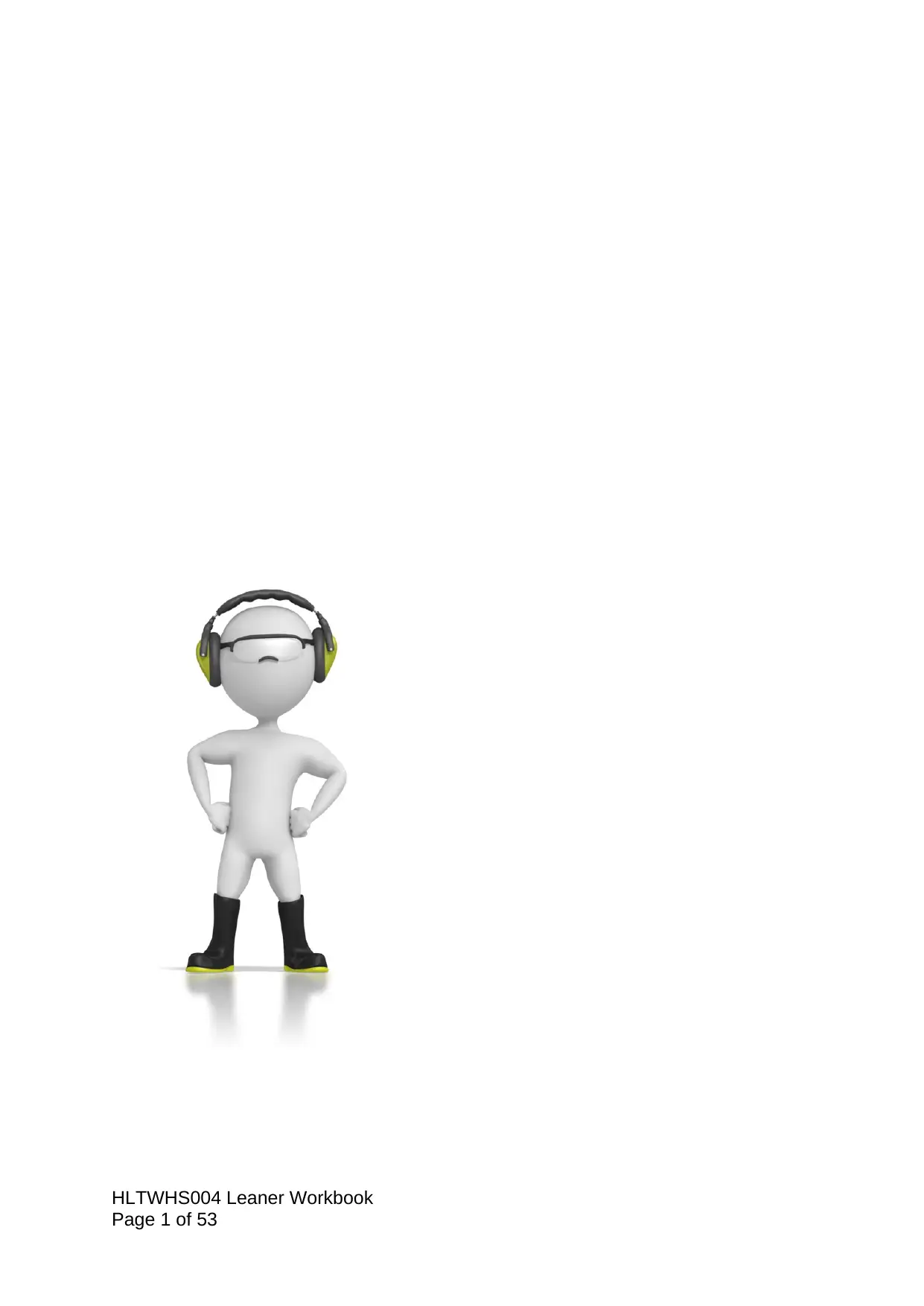
HLTWHS004 Leaner Workbook
Page 1 of 53
Page 1 of 53
Paraphrase This Document
Need a fresh take? Get an instant paraphrase of this document with our AI Paraphraser
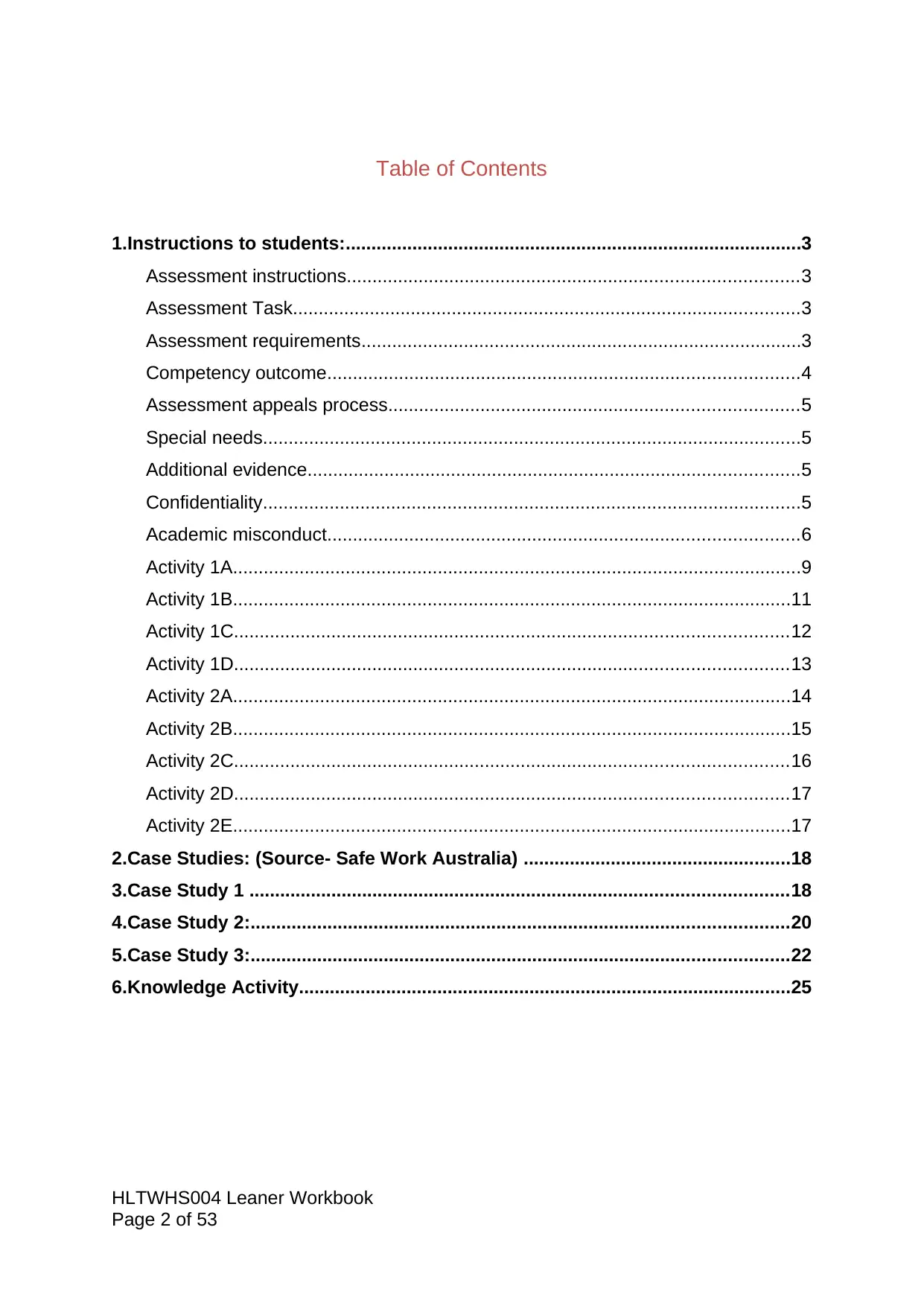
Table of Contents
1.Instructions to students:.........................................................................................3
Assessment instructions........................................................................................3
Assessment Task...................................................................................................3
Assessment requirements......................................................................................3
Competency outcome............................................................................................4
Assessment appeals process................................................................................5
Special needs.........................................................................................................5
Additional evidence................................................................................................5
Confidentiality.........................................................................................................5
Academic misconduct............................................................................................6
Activity 1A...............................................................................................................9
Activity 1B.............................................................................................................11
Activity 1C............................................................................................................12
Activity 1D............................................................................................................13
Activity 2A.............................................................................................................14
Activity 2B.............................................................................................................15
Activity 2C............................................................................................................16
Activity 2D............................................................................................................17
Activity 2E.............................................................................................................17
2.Case Studies: (Source- Safe Work Australia) ....................................................18
3.Case Study 1 .........................................................................................................18
4.Case Study 2:.........................................................................................................20
5.Case Study 3:.........................................................................................................22
6.Knowledge Activity................................................................................................25
HLTWHS004 Leaner Workbook
Page 2 of 53
1.Instructions to students:.........................................................................................3
Assessment instructions........................................................................................3
Assessment Task...................................................................................................3
Assessment requirements......................................................................................3
Competency outcome............................................................................................4
Assessment appeals process................................................................................5
Special needs.........................................................................................................5
Additional evidence................................................................................................5
Confidentiality.........................................................................................................5
Academic misconduct............................................................................................6
Activity 1A...............................................................................................................9
Activity 1B.............................................................................................................11
Activity 1C............................................................................................................12
Activity 1D............................................................................................................13
Activity 2A.............................................................................................................14
Activity 2B.............................................................................................................15
Activity 2C............................................................................................................16
Activity 2D............................................................................................................17
Activity 2E.............................................................................................................17
2.Case Studies: (Source- Safe Work Australia) ....................................................18
3.Case Study 1 .........................................................................................................18
4.Case Study 2:.........................................................................................................20
5.Case Study 3:.........................................................................................................22
6.Knowledge Activity................................................................................................25
HLTWHS004 Leaner Workbook
Page 2 of 53
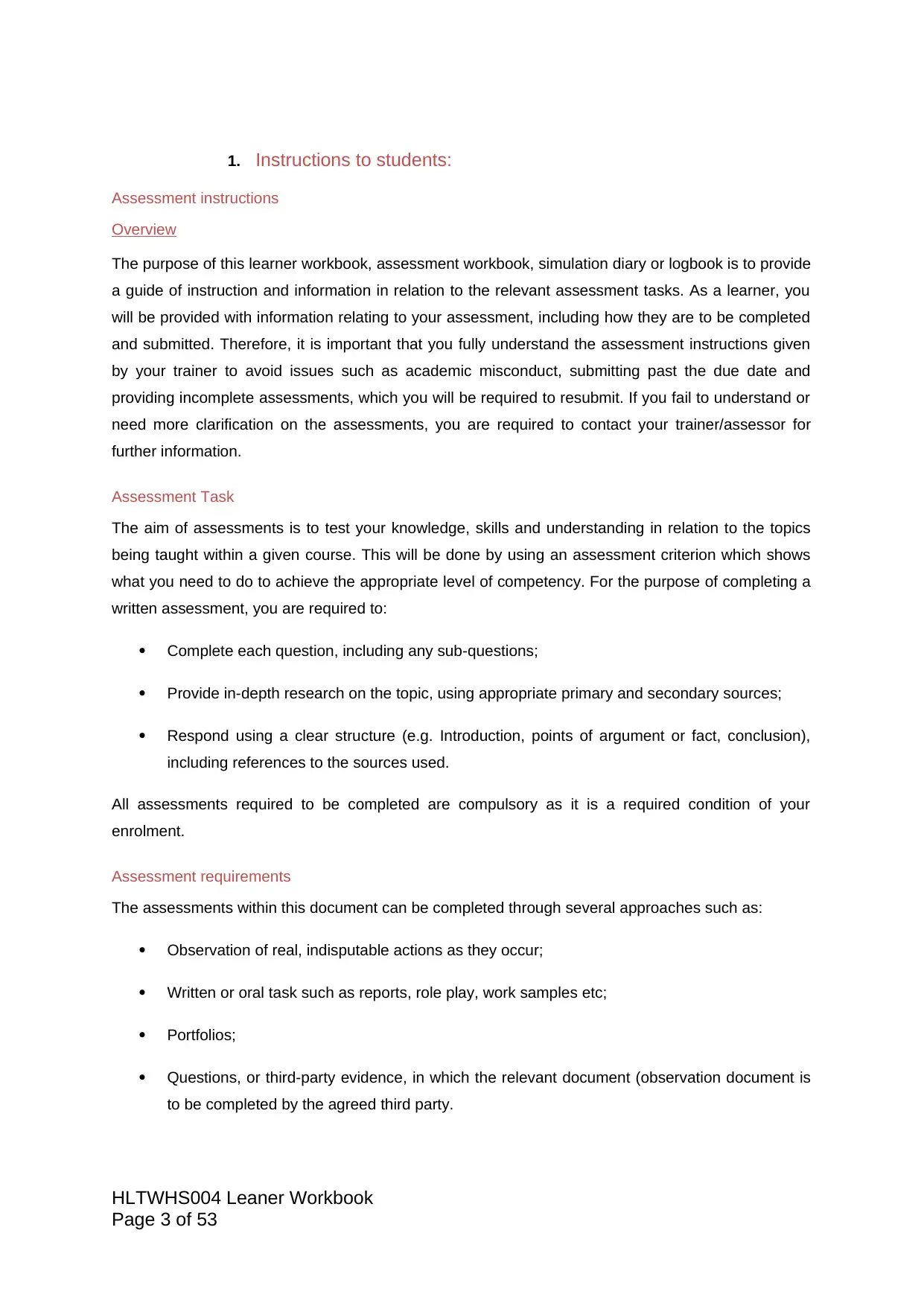
1. Instructions to students:
Assessment instructions
Overview
The purpose of this learner workbook, assessment workbook, simulation diary or logbook is to provide
a guide of instruction and information in relation to the relevant assessment tasks. As a learner, you
will be provided with information relating to your assessment, including how they are to be completed
and submitted. Therefore, it is important that you fully understand the assessment instructions given
by your trainer to avoid issues such as academic misconduct, submitting past the due date and
providing incomplete assessments, which you will be required to resubmit. If you fail to understand or
need more clarification on the assessments, you are required to contact your trainer/assessor for
further information.
Assessment Task
The aim of assessments is to test your knowledge, skills and understanding in relation to the topics
being taught within a given course. This will be done by using an assessment criterion which shows
what you need to do to achieve the appropriate level of competency. For the purpose of completing a
written assessment, you are required to:
Complete each question, including any sub-questions;
Provide in-depth research on the topic, using appropriate primary and secondary sources;
Respond using a clear structure (e.g. Introduction, points of argument or fact, conclusion),
including references to the sources used.
All assessments required to be completed are compulsory as it is a required condition of your
enrolment.
Assessment requirements
The assessments within this document can be completed through several approaches such as:
Observation of real, indisputable actions as they occur;
Written or oral task such as reports, role play, work samples etc;
Portfolios;
Questions, or third-party evidence, in which the relevant document (observation document is
to be completed by the agreed third party.
HLTWHS004 Leaner Workbook
Page 3 of 53
Assessment instructions
Overview
The purpose of this learner workbook, assessment workbook, simulation diary or logbook is to provide
a guide of instruction and information in relation to the relevant assessment tasks. As a learner, you
will be provided with information relating to your assessment, including how they are to be completed
and submitted. Therefore, it is important that you fully understand the assessment instructions given
by your trainer to avoid issues such as academic misconduct, submitting past the due date and
providing incomplete assessments, which you will be required to resubmit. If you fail to understand or
need more clarification on the assessments, you are required to contact your trainer/assessor for
further information.
Assessment Task
The aim of assessments is to test your knowledge, skills and understanding in relation to the topics
being taught within a given course. This will be done by using an assessment criterion which shows
what you need to do to achieve the appropriate level of competency. For the purpose of completing a
written assessment, you are required to:
Complete each question, including any sub-questions;
Provide in-depth research on the topic, using appropriate primary and secondary sources;
Respond using a clear structure (e.g. Introduction, points of argument or fact, conclusion),
including references to the sources used.
All assessments required to be completed are compulsory as it is a required condition of your
enrolment.
Assessment requirements
The assessments within this document can be completed through several approaches such as:
Observation of real, indisputable actions as they occur;
Written or oral task such as reports, role play, work samples etc;
Portfolios;
Questions, or third-party evidence, in which the relevant document (observation document is
to be completed by the agreed third party.
HLTWHS004 Leaner Workbook
Page 3 of 53
⊘ This is a preview!⊘
Do you want full access?
Subscribe today to unlock all pages.

Trusted by 1+ million students worldwide
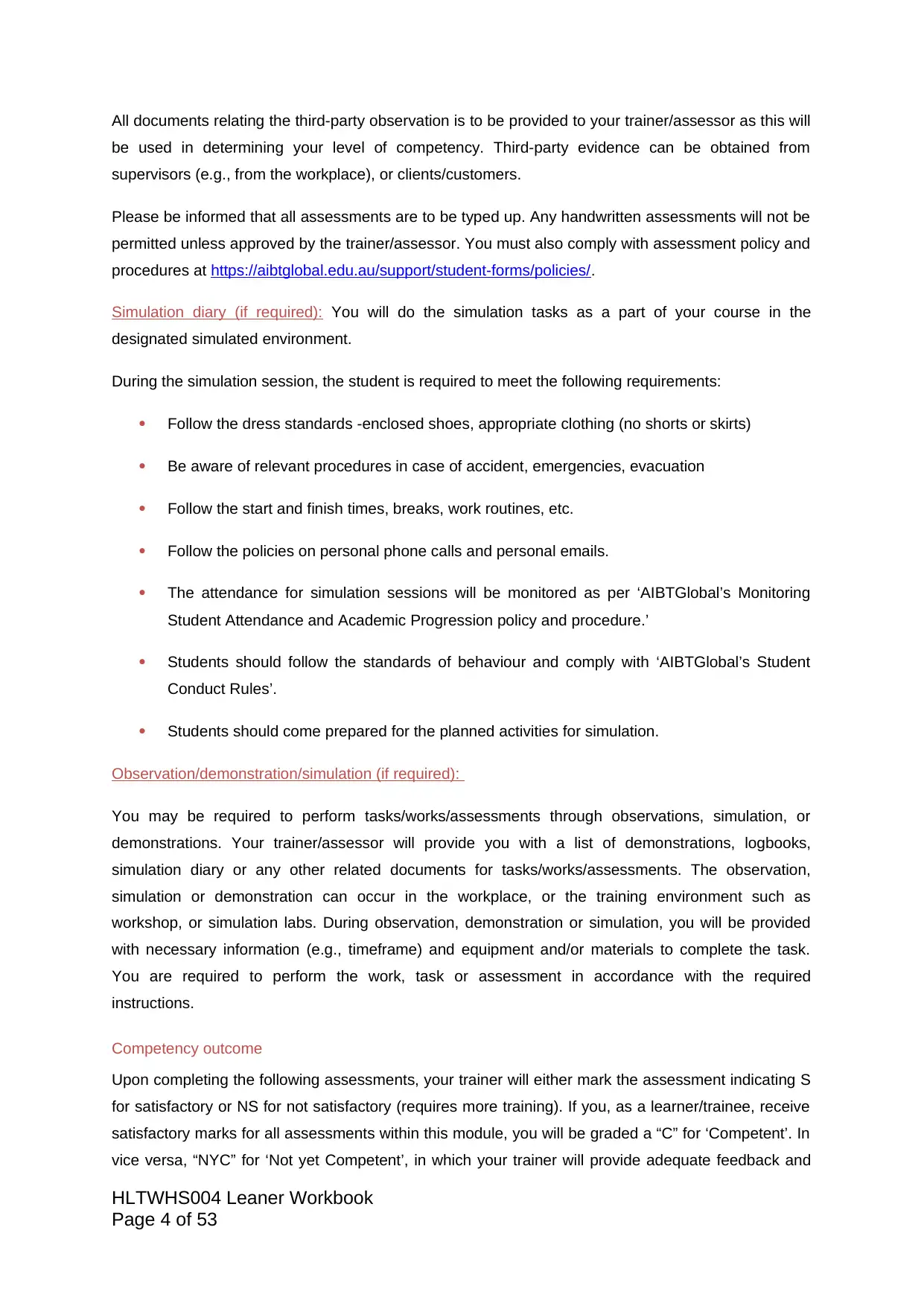
All documents relating the third-party observation is to be provided to your trainer/assessor as this will
be used in determining your level of competency. Third-party evidence can be obtained from
supervisors (e.g., from the workplace), or clients/customers.
Please be informed that all assessments are to be typed up. Any handwritten assessments will not be
permitted unless approved by the trainer/assessor. You must also comply with assessment policy and
procedures at https://aibtglobal.edu.au/support/student-forms/policies/.
Simulation diary (if required): You will do the simulation tasks as a part of your course in the
designated simulated environment.
During the simulation session, the student is required to meet the following requirements:
Follow the dress standards -enclosed shoes, appropriate clothing (no shorts or skirts)
Be aware of relevant procedures in case of accident, emergencies, evacuation
Follow the start and finish times, breaks, work routines, etc.
Follow the policies on personal phone calls and personal emails.
The attendance for simulation sessions will be monitored as per ‘AIBTGlobal’s Monitoring
Student Attendance and Academic Progression policy and procedure.’
Students should follow the standards of behaviour and comply with ‘AIBTGlobal’s Student
Conduct Rules’.
Students should come prepared for the planned activities for simulation.
Observation/demonstration/simulation (if required):
You may be required to perform tasks/works/assessments through observations, simulation, or
demonstrations. Your trainer/assessor will provide you with a list of demonstrations, logbooks,
simulation diary or any other related documents for tasks/works/assessments. The observation,
simulation or demonstration can occur in the workplace, or the training environment such as
workshop, or simulation labs. During observation, demonstration or simulation, you will be provided
with necessary information (e.g., timeframe) and equipment and/or materials to complete the task.
You are required to perform the work, task or assessment in accordance with the required
instructions.
Competency outcome
Upon completing the following assessments, your trainer will either mark the assessment indicating S
for satisfactory or NS for not satisfactory (requires more training). If you, as a learner/trainee, receive
satisfactory marks for all assessments within this module, you will be graded a “C” for ‘Competent’. In
vice versa, “NYC” for ‘Not yet Competent’, in which your trainer will provide adequate feedback and
HLTWHS004 Leaner Workbook
Page 4 of 53
be used in determining your level of competency. Third-party evidence can be obtained from
supervisors (e.g., from the workplace), or clients/customers.
Please be informed that all assessments are to be typed up. Any handwritten assessments will not be
permitted unless approved by the trainer/assessor. You must also comply with assessment policy and
procedures at https://aibtglobal.edu.au/support/student-forms/policies/.
Simulation diary (if required): You will do the simulation tasks as a part of your course in the
designated simulated environment.
During the simulation session, the student is required to meet the following requirements:
Follow the dress standards -enclosed shoes, appropriate clothing (no shorts or skirts)
Be aware of relevant procedures in case of accident, emergencies, evacuation
Follow the start and finish times, breaks, work routines, etc.
Follow the policies on personal phone calls and personal emails.
The attendance for simulation sessions will be monitored as per ‘AIBTGlobal’s Monitoring
Student Attendance and Academic Progression policy and procedure.’
Students should follow the standards of behaviour and comply with ‘AIBTGlobal’s Student
Conduct Rules’.
Students should come prepared for the planned activities for simulation.
Observation/demonstration/simulation (if required):
You may be required to perform tasks/works/assessments through observations, simulation, or
demonstrations. Your trainer/assessor will provide you with a list of demonstrations, logbooks,
simulation diary or any other related documents for tasks/works/assessments. The observation,
simulation or demonstration can occur in the workplace, or the training environment such as
workshop, or simulation labs. During observation, demonstration or simulation, you will be provided
with necessary information (e.g., timeframe) and equipment and/or materials to complete the task.
You are required to perform the work, task or assessment in accordance with the required
instructions.
Competency outcome
Upon completing the following assessments, your trainer will either mark the assessment indicating S
for satisfactory or NS for not satisfactory (requires more training). If you, as a learner/trainee, receive
satisfactory marks for all assessments within this module, you will be graded a “C” for ‘Competent’. In
vice versa, “NYC” for ‘Not yet Competent’, in which your trainer will provide adequate feedback and
HLTWHS004 Leaner Workbook
Page 4 of 53
Paraphrase This Document
Need a fresh take? Get an instant paraphrase of this document with our AI Paraphraser
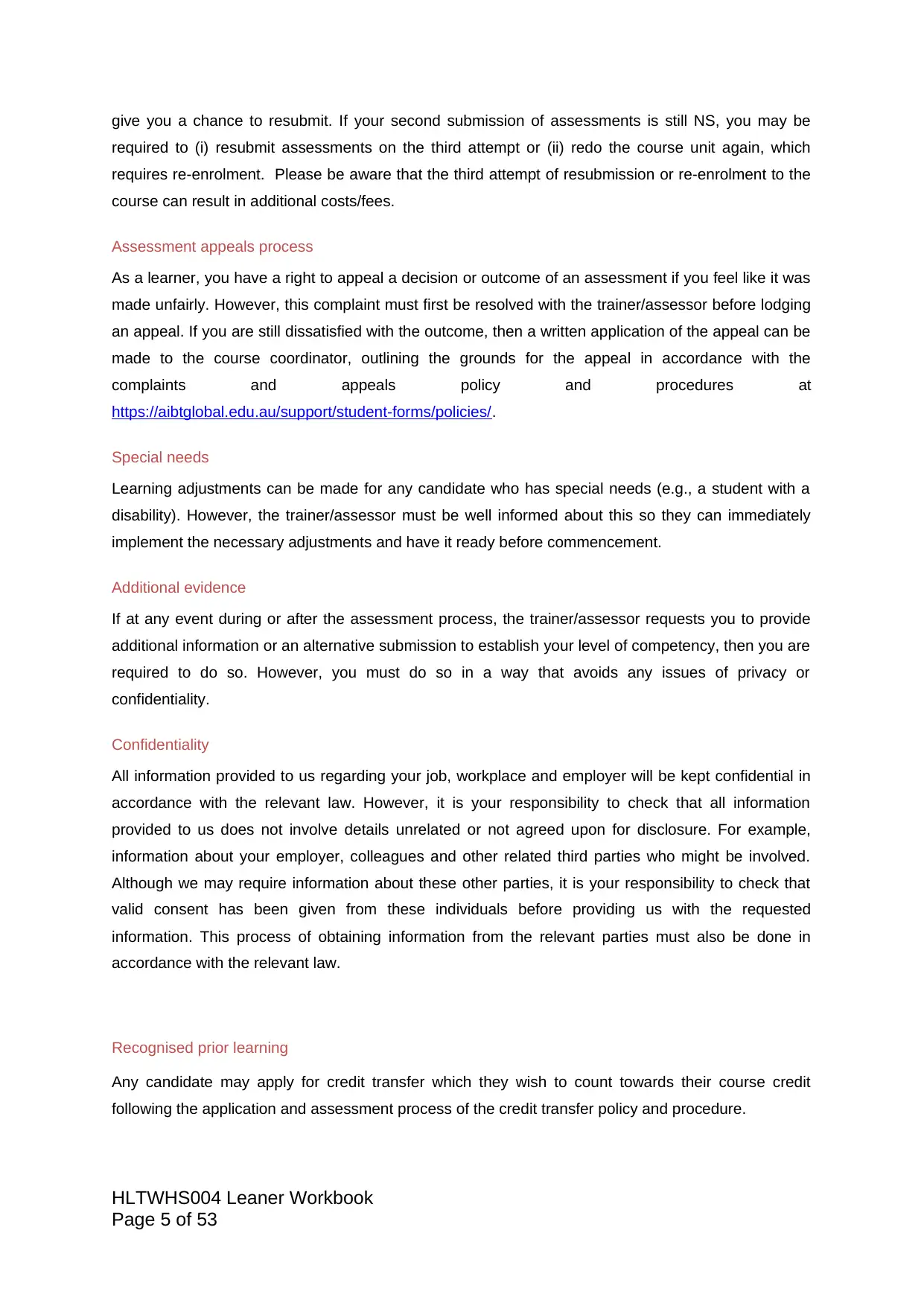
give you a chance to resubmit. If your second submission of assessments is still NS, you may be
required to (i) resubmit assessments on the third attempt or (ii) redo the course unit again, which
requires re-enrolment. Please be aware that the third attempt of resubmission or re-enrolment to the
course can result in additional costs/fees.
Assessment appeals process
As a learner, you have a right to appeal a decision or outcome of an assessment if you feel like it was
made unfairly. However, this complaint must first be resolved with the trainer/assessor before lodging
an appeal. If you are still dissatisfied with the outcome, then a written application of the appeal can be
made to the course coordinator, outlining the grounds for the appeal in accordance with the
complaints and appeals policy and procedures at
https://aibtglobal.edu.au/support/student-forms/policies/.
Special needs
Learning adjustments can be made for any candidate who has special needs (e.g., a student with a
disability). However, the trainer/assessor must be well informed about this so they can immediately
implement the necessary adjustments and have it ready before commencement.
Additional evidence
If at any event during or after the assessment process, the trainer/assessor requests you to provide
additional information or an alternative submission to establish your level of competency, then you are
required to do so. However, you must do so in a way that avoids any issues of privacy or
confidentiality.
Confidentiality
All information provided to us regarding your job, workplace and employer will be kept confidential in
accordance with the relevant law. However, it is your responsibility to check that all information
provided to us does not involve details unrelated or not agreed upon for disclosure. For example,
information about your employer, colleagues and other related third parties who might be involved.
Although we may require information about these other parties, it is your responsibility to check that
valid consent has been given from these individuals before providing us with the requested
information. This process of obtaining information from the relevant parties must also be done in
accordance with the relevant law.
Recognised prior learning
Any candidate may apply for credit transfer which they wish to count towards their course credit
following the application and assessment process of the credit transfer policy and procedure.
HLTWHS004 Leaner Workbook
Page 5 of 53
required to (i) resubmit assessments on the third attempt or (ii) redo the course unit again, which
requires re-enrolment. Please be aware that the third attempt of resubmission or re-enrolment to the
course can result in additional costs/fees.
Assessment appeals process
As a learner, you have a right to appeal a decision or outcome of an assessment if you feel like it was
made unfairly. However, this complaint must first be resolved with the trainer/assessor before lodging
an appeal. If you are still dissatisfied with the outcome, then a written application of the appeal can be
made to the course coordinator, outlining the grounds for the appeal in accordance with the
complaints and appeals policy and procedures at
https://aibtglobal.edu.au/support/student-forms/policies/.
Special needs
Learning adjustments can be made for any candidate who has special needs (e.g., a student with a
disability). However, the trainer/assessor must be well informed about this so they can immediately
implement the necessary adjustments and have it ready before commencement.
Additional evidence
If at any event during or after the assessment process, the trainer/assessor requests you to provide
additional information or an alternative submission to establish your level of competency, then you are
required to do so. However, you must do so in a way that avoids any issues of privacy or
confidentiality.
Confidentiality
All information provided to us regarding your job, workplace and employer will be kept confidential in
accordance with the relevant law. However, it is your responsibility to check that all information
provided to us does not involve details unrelated or not agreed upon for disclosure. For example,
information about your employer, colleagues and other related third parties who might be involved.
Although we may require information about these other parties, it is your responsibility to check that
valid consent has been given from these individuals before providing us with the requested
information. This process of obtaining information from the relevant parties must also be done in
accordance with the relevant law.
Recognised prior learning
Any candidate may apply for credit transfer which they wish to count towards their course credit
following the application and assessment process of the credit transfer policy and procedure.
HLTWHS004 Leaner Workbook
Page 5 of 53
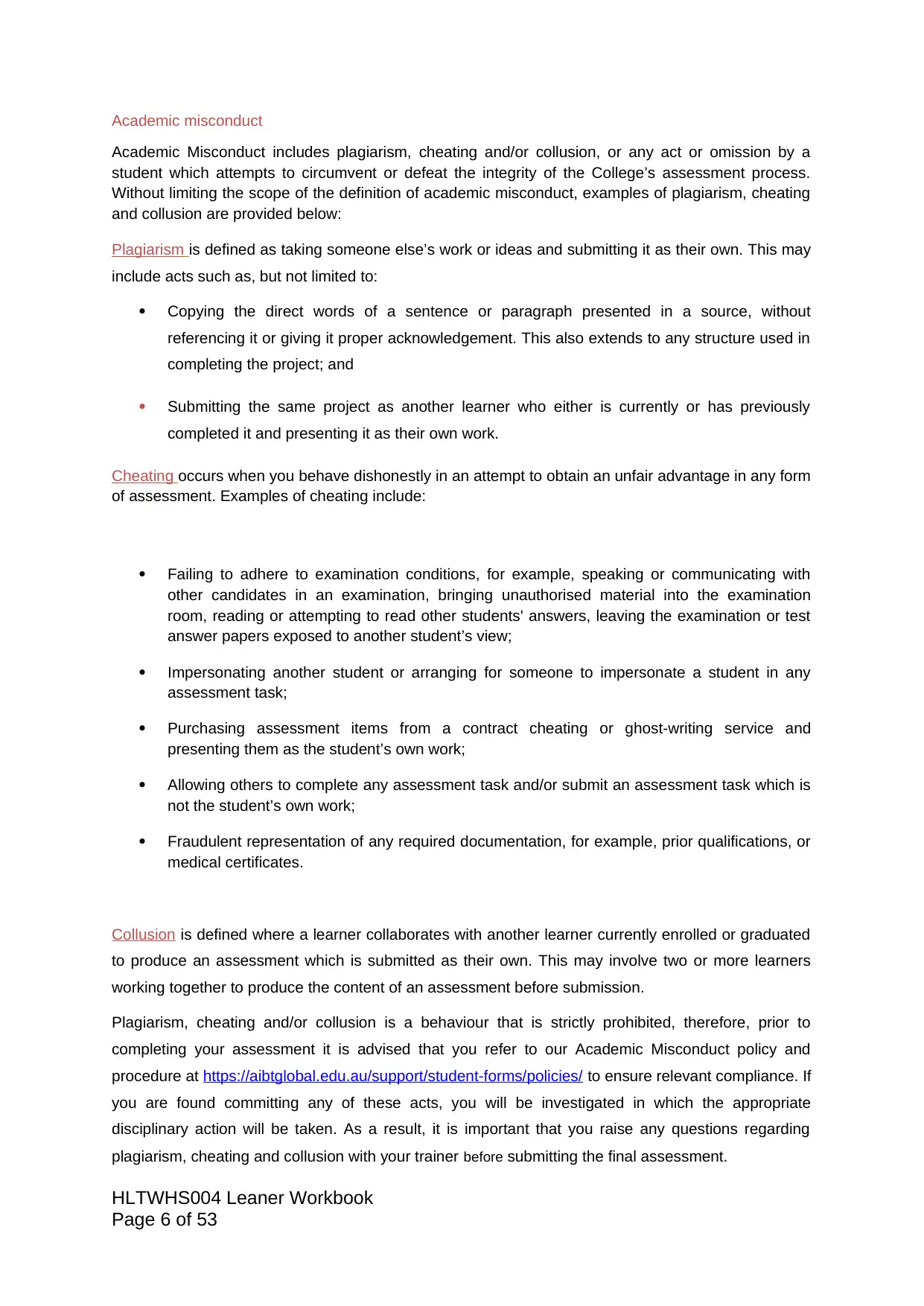
Academic misconduct
Academic Misconduct includes plagiarism, cheating and/or collusion, or any act or omission by a
student which attempts to circumvent or defeat the integrity of the College’s assessment process.
Without limiting the scope of the definition of academic misconduct, examples of plagiarism, cheating
and collusion are provided below:
Plagiarism is defined as taking someone else’s work or ideas and submitting it as their own. This may
include acts such as, but not limited to:
Copying the direct words of a sentence or paragraph presented in a source, without
referencing it or giving it proper acknowledgement. This also extends to any structure used in
completing the project; and
Submitting the same project as another learner who either is currently or has previously
completed it and presenting it as their own work.
Cheating occurs when you behave dishonestly in an attempt to obtain an unfair advantage in any form
of assessment. Examples of cheating include:
Failing to adhere to examination conditions, for example, speaking or communicating with
other candidates in an examination, bringing unauthorised material into the examination
room, reading or attempting to read other students' answers, leaving the examination or test
answer papers exposed to another student’s view;
Impersonating another student or arranging for someone to impersonate a student in any
assessment task;
Purchasing assessment items from a contract cheating or ghost-writing service and
presenting them as the student’s own work;
Allowing others to complete any assessment task and/or submit an assessment task which is
not the student’s own work;
Fraudulent representation of any required documentation, for example, prior qualifications, or
medical certificates.
Collusion is defined where a learner collaborates with another learner currently enrolled or graduated
to produce an assessment which is submitted as their own. This may involve two or more learners
working together to produce the content of an assessment before submission.
Plagiarism, cheating and/or collusion is a behaviour that is strictly prohibited, therefore, prior to
completing your assessment it is advised that you refer to our Academic Misconduct policy and
procedure at https://aibtglobal.edu.au/support/student-forms/policies/ to ensure relevant compliance. If
you are found committing any of these acts, you will be investigated in which the appropriate
disciplinary action will be taken. As a result, it is important that you raise any questions regarding
plagiarism, cheating and collusion with your trainer before submitting the final assessment.
HLTWHS004 Leaner Workbook
Page 6 of 53
Academic Misconduct includes plagiarism, cheating and/or collusion, or any act or omission by a
student which attempts to circumvent or defeat the integrity of the College’s assessment process.
Without limiting the scope of the definition of academic misconduct, examples of plagiarism, cheating
and collusion are provided below:
Plagiarism is defined as taking someone else’s work or ideas and submitting it as their own. This may
include acts such as, but not limited to:
Copying the direct words of a sentence or paragraph presented in a source, without
referencing it or giving it proper acknowledgement. This also extends to any structure used in
completing the project; and
Submitting the same project as another learner who either is currently or has previously
completed it and presenting it as their own work.
Cheating occurs when you behave dishonestly in an attempt to obtain an unfair advantage in any form
of assessment. Examples of cheating include:
Failing to adhere to examination conditions, for example, speaking or communicating with
other candidates in an examination, bringing unauthorised material into the examination
room, reading or attempting to read other students' answers, leaving the examination or test
answer papers exposed to another student’s view;
Impersonating another student or arranging for someone to impersonate a student in any
assessment task;
Purchasing assessment items from a contract cheating or ghost-writing service and
presenting them as the student’s own work;
Allowing others to complete any assessment task and/or submit an assessment task which is
not the student’s own work;
Fraudulent representation of any required documentation, for example, prior qualifications, or
medical certificates.
Collusion is defined where a learner collaborates with another learner currently enrolled or graduated
to produce an assessment which is submitted as their own. This may involve two or more learners
working together to produce the content of an assessment before submission.
Plagiarism, cheating and/or collusion is a behaviour that is strictly prohibited, therefore, prior to
completing your assessment it is advised that you refer to our Academic Misconduct policy and
procedure at https://aibtglobal.edu.au/support/student-forms/policies/ to ensure relevant compliance. If
you are found committing any of these acts, you will be investigated in which the appropriate
disciplinary action will be taken. As a result, it is important that you raise any questions regarding
plagiarism, cheating and collusion with your trainer before submitting the final assessment.
HLTWHS004 Leaner Workbook
Page 6 of 53
⊘ This is a preview!⊘
Do you want full access?
Subscribe today to unlock all pages.

Trusted by 1+ million students worldwide
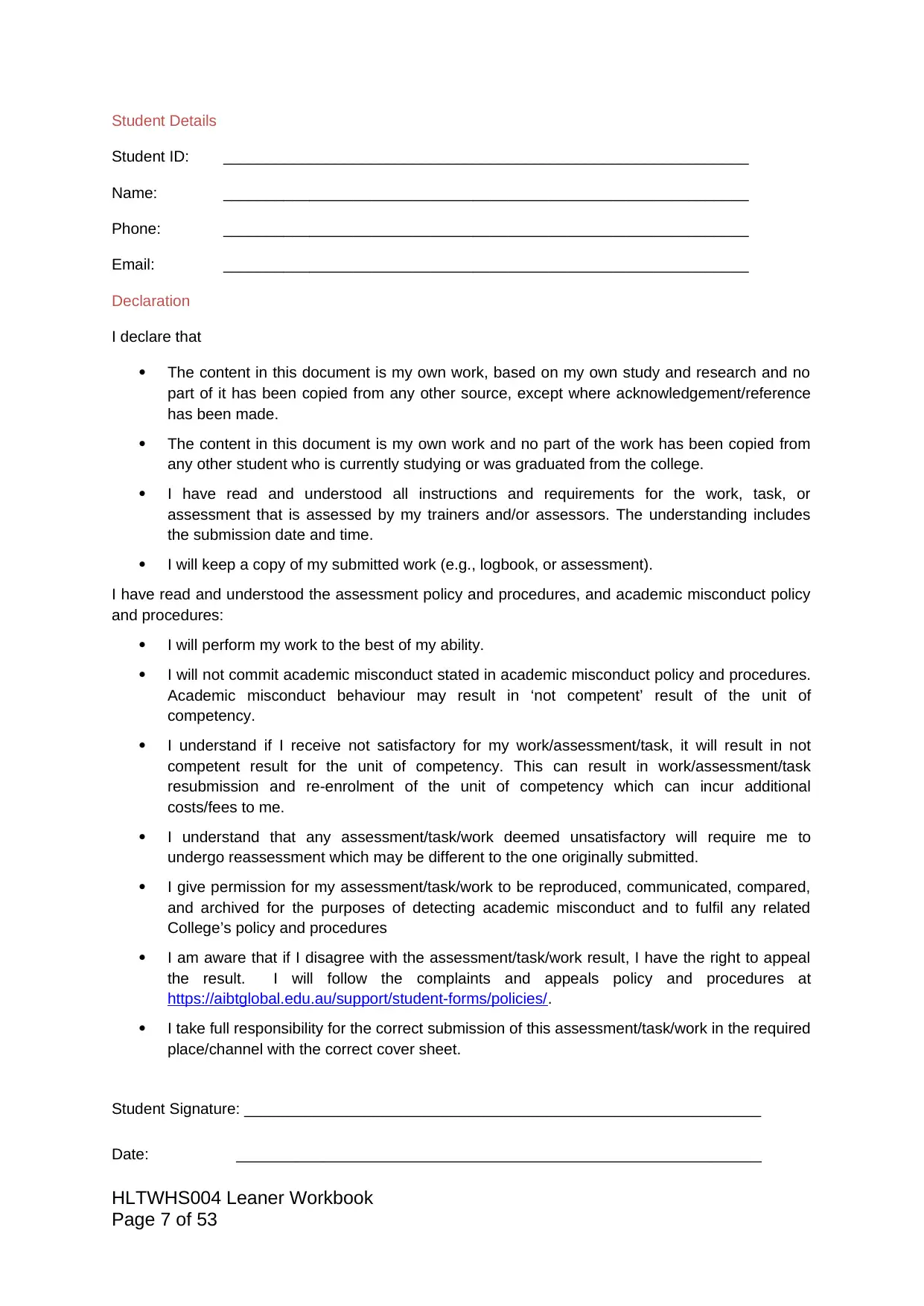
Student Details
Student ID: _____________________________________________________________
Name: _____________________________________________________________
Phone: _____________________________________________________________
Email: _____________________________________________________________
Declaration
I declare that
The content in this document is my own work, based on my own study and research and no
part of it has been copied from any other source, except where acknowledgement/reference
has been made.
The content in this document is my own work and no part of the work has been copied from
any other student who is currently studying or was graduated from the college.
I have read and understood all instructions and requirements for the work, task, or
assessment that is assessed by my trainers and/or assessors. The understanding includes
the submission date and time.
I will keep a copy of my submitted work (e.g., logbook, or assessment).
I have read and understood the assessment policy and procedures, and academic misconduct policy
and procedures:
I will perform my work to the best of my ability.
I will not commit academic misconduct stated in academic misconduct policy and procedures.
Academic misconduct behaviour may result in ‘not competent’ result of the unit of
competency.
I understand if I receive not satisfactory for my work/assessment/task, it will result in not
competent result for the unit of competency. This can result in work/assessment/task
resubmission and re-enrolment of the unit of competency which can incur additional
costs/fees to me.
I understand that any assessment/task/work deemed unsatisfactory will require me to
undergo reassessment which may be different to the one originally submitted.
I give permission for my assessment/task/work to be reproduced, communicated, compared,
and archived for the purposes of detecting academic misconduct and to fulfil any related
College’s policy and procedures
I am aware that if I disagree with the assessment/task/work result, I have the right to appeal
the result. I will follow the complaints and appeals policy and procedures at
https://aibtglobal.edu.au/support/student-forms/policies/.
I take full responsibility for the correct submission of this assessment/task/work in the required
place/channel with the correct cover sheet.
Student Signature: ____________________________________________________________
Date: _____________________________________________________________
HLTWHS004 Leaner Workbook
Page 7 of 53
Student ID: _____________________________________________________________
Name: _____________________________________________________________
Phone: _____________________________________________________________
Email: _____________________________________________________________
Declaration
I declare that
The content in this document is my own work, based on my own study and research and no
part of it has been copied from any other source, except where acknowledgement/reference
has been made.
The content in this document is my own work and no part of the work has been copied from
any other student who is currently studying or was graduated from the college.
I have read and understood all instructions and requirements for the work, task, or
assessment that is assessed by my trainers and/or assessors. The understanding includes
the submission date and time.
I will keep a copy of my submitted work (e.g., logbook, or assessment).
I have read and understood the assessment policy and procedures, and academic misconduct policy
and procedures:
I will perform my work to the best of my ability.
I will not commit academic misconduct stated in academic misconduct policy and procedures.
Academic misconduct behaviour may result in ‘not competent’ result of the unit of
competency.
I understand if I receive not satisfactory for my work/assessment/task, it will result in not
competent result for the unit of competency. This can result in work/assessment/task
resubmission and re-enrolment of the unit of competency which can incur additional
costs/fees to me.
I understand that any assessment/task/work deemed unsatisfactory will require me to
undergo reassessment which may be different to the one originally submitted.
I give permission for my assessment/task/work to be reproduced, communicated, compared,
and archived for the purposes of detecting academic misconduct and to fulfil any related
College’s policy and procedures
I am aware that if I disagree with the assessment/task/work result, I have the right to appeal
the result. I will follow the complaints and appeals policy and procedures at
https://aibtglobal.edu.au/support/student-forms/policies/.
I take full responsibility for the correct submission of this assessment/task/work in the required
place/channel with the correct cover sheet.
Student Signature: ____________________________________________________________
Date: _____________________________________________________________
HLTWHS004 Leaner Workbook
Page 7 of 53
Paraphrase This Document
Need a fresh take? Get an instant paraphrase of this document with our AI Paraphraser
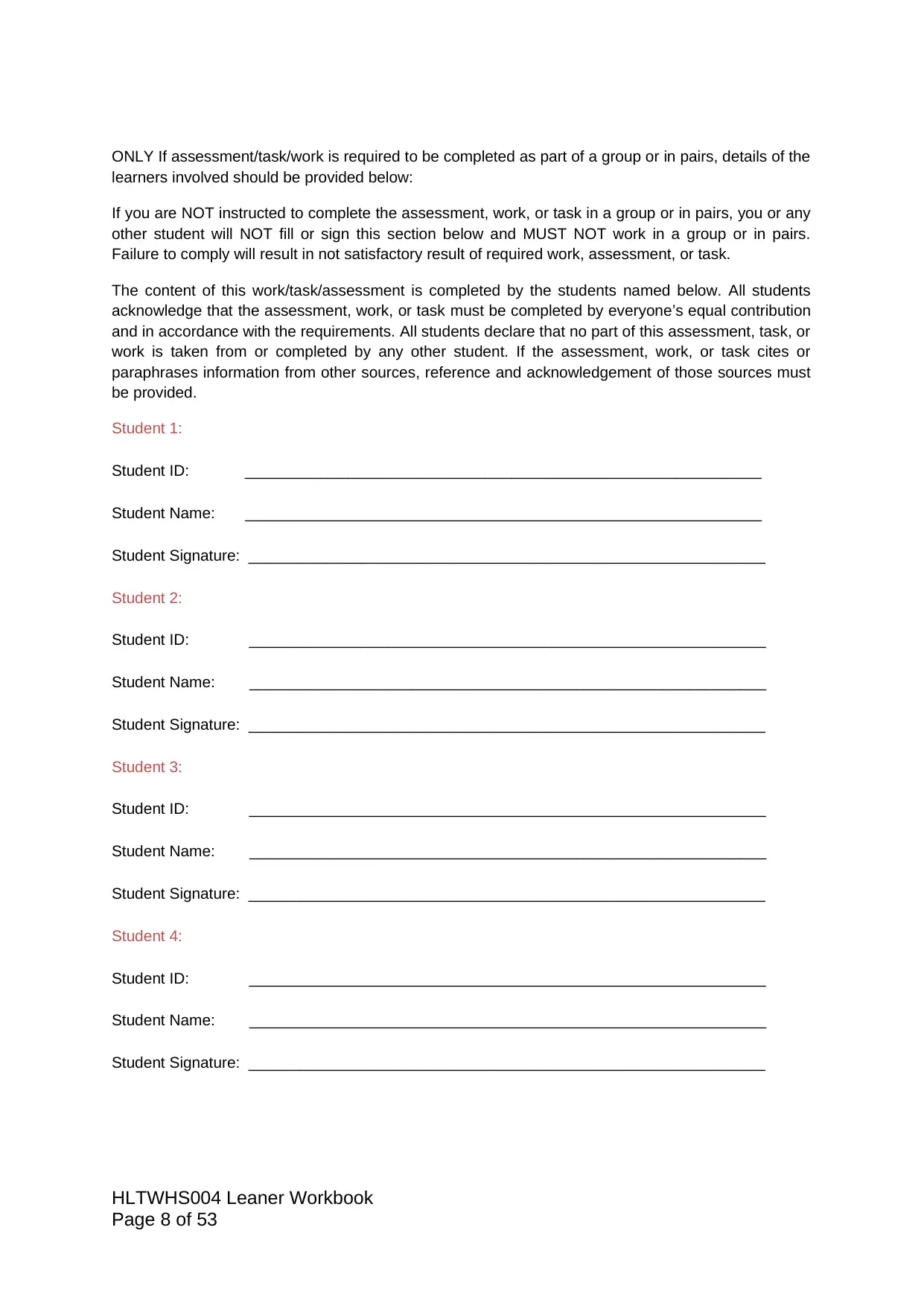
ONLY If assessment/task/work is required to be completed as part of a group or in pairs, details of the
learners involved should be provided below:
If you are NOT instructed to complete the assessment, work, or task in a group or in pairs, you or any
other student will NOT fill or sign this section below and MUST NOT work in a group or in pairs.
Failure to comply will result in not satisfactory result of required work, assessment, or task.
The content of this work/task/assessment is completed by the students named below. All students
acknowledge that the assessment, work, or task must be completed by everyone’s equal contribution
and in accordance with the requirements. All students declare that no part of this assessment, task, or
work is taken from or completed by any other student. If the assessment, work, or task cites or
paraphrases information from other sources, reference and acknowledgement of those sources must
be provided.
Student 1:
Student ID: ____________________________________________________________
Student Name: ____________________________________________________________
Student Signature: ____________________________________________________________
Student 2:
Student ID: ____________________________________________________________
Student Name: ____________________________________________________________
Student Signature: ____________________________________________________________
Student 3:
Student ID: ____________________________________________________________
Student Name: ____________________________________________________________
Student Signature: ____________________________________________________________
Student 4:
Student ID: ____________________________________________________________
Student Name: ____________________________________________________________
Student Signature: ____________________________________________________________
HLTWHS004 Leaner Workbook
Page 8 of 53
learners involved should be provided below:
If you are NOT instructed to complete the assessment, work, or task in a group or in pairs, you or any
other student will NOT fill or sign this section below and MUST NOT work in a group or in pairs.
Failure to comply will result in not satisfactory result of required work, assessment, or task.
The content of this work/task/assessment is completed by the students named below. All students
acknowledge that the assessment, work, or task must be completed by everyone’s equal contribution
and in accordance with the requirements. All students declare that no part of this assessment, task, or
work is taken from or completed by any other student. If the assessment, work, or task cites or
paraphrases information from other sources, reference and acknowledgement of those sources must
be provided.
Student 1:
Student ID: ____________________________________________________________
Student Name: ____________________________________________________________
Student Signature: ____________________________________________________________
Student 2:
Student ID: ____________________________________________________________
Student Name: ____________________________________________________________
Student Signature: ____________________________________________________________
Student 3:
Student ID: ____________________________________________________________
Student Name: ____________________________________________________________
Student Signature: ____________________________________________________________
Student 4:
Student ID: ____________________________________________________________
Student Name: ____________________________________________________________
Student Signature: ____________________________________________________________
HLTWHS004 Leaner Workbook
Page 8 of 53
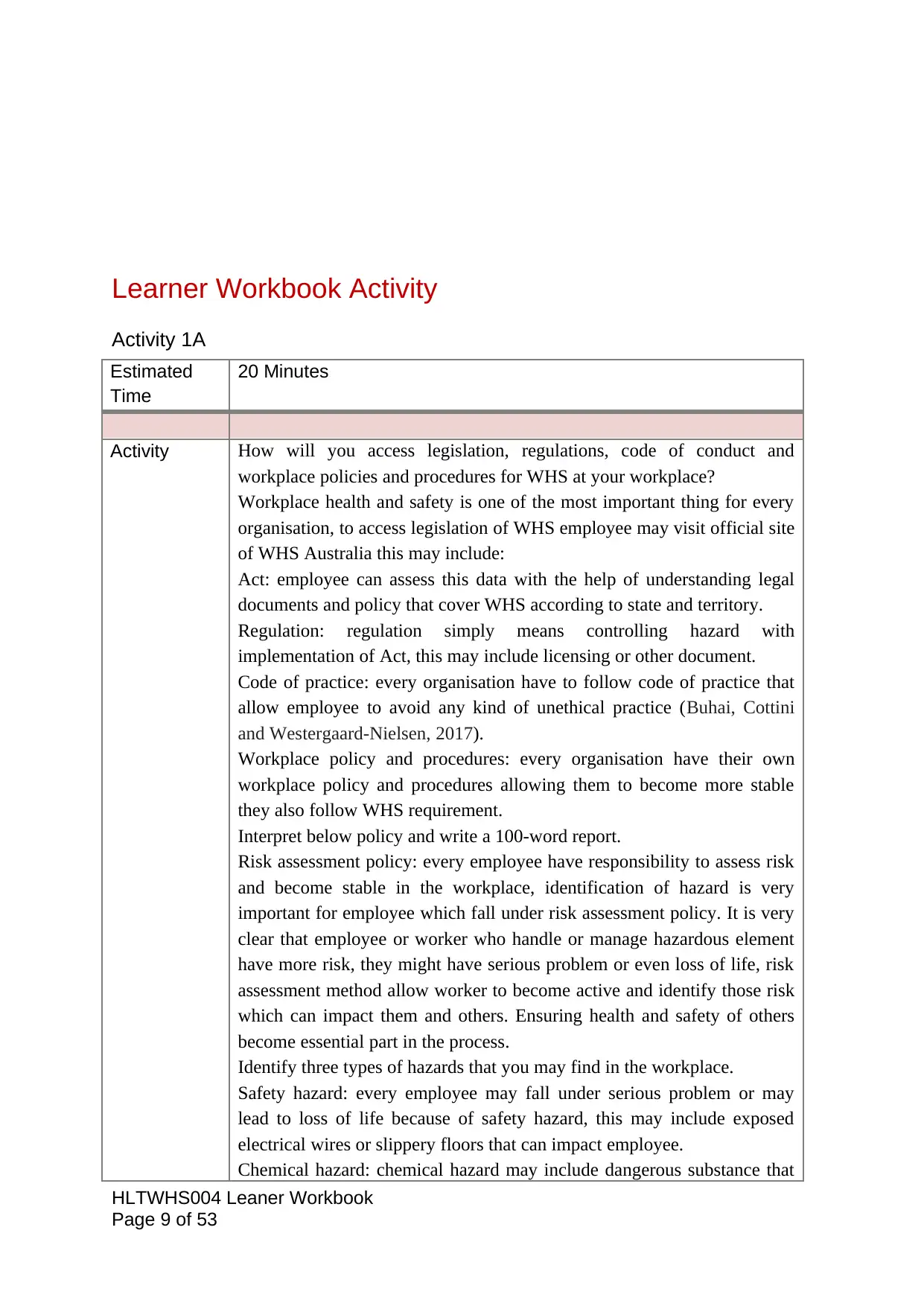
Learner Workbook Activity
Activity 1A
Estimated
Time
20 Minutes
Activity How will you access legislation, regulations, code of conduct and
workplace policies and procedures for WHS at your workplace?
Workplace health and safety is one of the most important thing for every
organisation, to access legislation of WHS employee may visit official site
of WHS Australia this may include:
Act: employee can assess this data with the help of understanding legal
documents and policy that cover WHS according to state and territory.
Regulation: regulation simply means controlling hazard with
implementation of Act, this may include licensing or other document.
Code of practice: every organisation have to follow code of practice that
allow employee to avoid any kind of unethical practice (Buhai, Cottini
and Westergaard‐Nielsen, 2017).
Workplace policy and procedures: every organisation have their own
workplace policy and procedures allowing them to become more stable
they also follow WHS requirement.
Interpret below policy and write a 100-word report.
Risk assessment policy: every employee have responsibility to assess risk
and become stable in the workplace, identification of hazard is very
important for employee which fall under risk assessment policy. It is very
clear that employee or worker who handle or manage hazardous element
have more risk, they might have serious problem or even loss of life, risk
assessment method allow worker to become active and identify those risk
which can impact them and others. Ensuring health and safety of others
become essential part in the process.
Identify three types of hazards that you may find in the workplace.
Safety hazard: every employee may fall under serious problem or may
lead to loss of life because of safety hazard, this may include exposed
electrical wires or slippery floors that can impact employee.
Chemical hazard: chemical hazard may include dangerous substance that
HLTWHS004 Leaner Workbook
Page 9 of 53
Activity 1A
Estimated
Time
20 Minutes
Activity How will you access legislation, regulations, code of conduct and
workplace policies and procedures for WHS at your workplace?
Workplace health and safety is one of the most important thing for every
organisation, to access legislation of WHS employee may visit official site
of WHS Australia this may include:
Act: employee can assess this data with the help of understanding legal
documents and policy that cover WHS according to state and territory.
Regulation: regulation simply means controlling hazard with
implementation of Act, this may include licensing or other document.
Code of practice: every organisation have to follow code of practice that
allow employee to avoid any kind of unethical practice (Buhai, Cottini
and Westergaard‐Nielsen, 2017).
Workplace policy and procedures: every organisation have their own
workplace policy and procedures allowing them to become more stable
they also follow WHS requirement.
Interpret below policy and write a 100-word report.
Risk assessment policy: every employee have responsibility to assess risk
and become stable in the workplace, identification of hazard is very
important for employee which fall under risk assessment policy. It is very
clear that employee or worker who handle or manage hazardous element
have more risk, they might have serious problem or even loss of life, risk
assessment method allow worker to become active and identify those risk
which can impact them and others. Ensuring health and safety of others
become essential part in the process.
Identify three types of hazards that you may find in the workplace.
Safety hazard: every employee may fall under serious problem or may
lead to loss of life because of safety hazard, this may include exposed
electrical wires or slippery floors that can impact employee.
Chemical hazard: chemical hazard may include dangerous substance that
HLTWHS004 Leaner Workbook
Page 9 of 53
⊘ This is a preview!⊘
Do you want full access?
Subscribe today to unlock all pages.

Trusted by 1+ million students worldwide
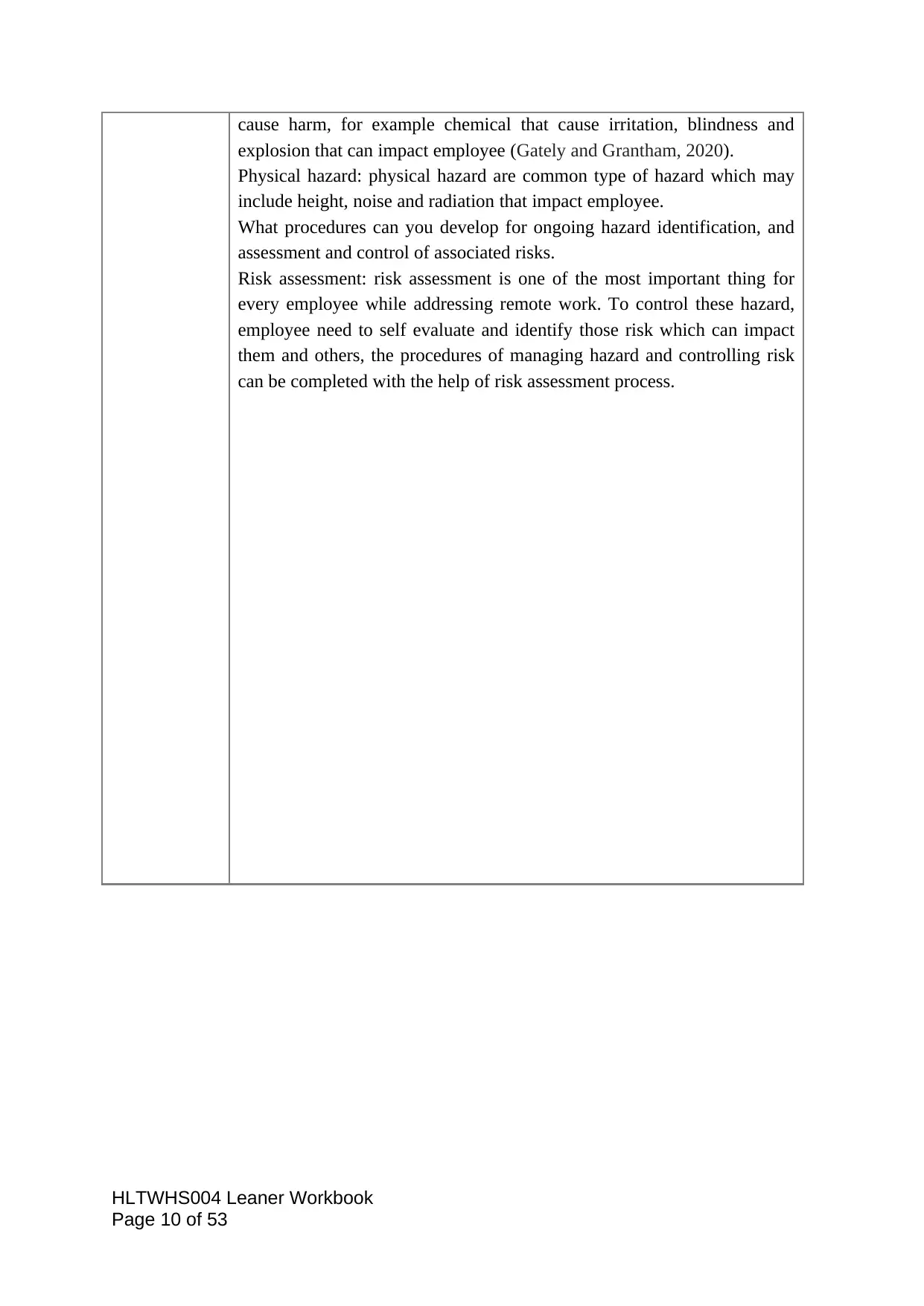
cause harm, for example chemical that cause irritation, blindness and
explosion that can impact employee (Gately and Grantham, 2020).
Physical hazard: physical hazard are common type of hazard which may
include height, noise and radiation that impact employee.
What procedures can you develop for ongoing hazard identification, and
assessment and control of associated risks.
Risk assessment: risk assessment is one of the most important thing for
every employee while addressing remote work. To control these hazard,
employee need to self evaluate and identify those risk which can impact
them and others, the procedures of managing hazard and controlling risk
can be completed with the help of risk assessment process.
HLTWHS004 Leaner Workbook
Page 10 of 53
explosion that can impact employee (Gately and Grantham, 2020).
Physical hazard: physical hazard are common type of hazard which may
include height, noise and radiation that impact employee.
What procedures can you develop for ongoing hazard identification, and
assessment and control of associated risks.
Risk assessment: risk assessment is one of the most important thing for
every employee while addressing remote work. To control these hazard,
employee need to self evaluate and identify those risk which can impact
them and others, the procedures of managing hazard and controlling risk
can be completed with the help of risk assessment process.
HLTWHS004 Leaner Workbook
Page 10 of 53
Paraphrase This Document
Need a fresh take? Get an instant paraphrase of this document with our AI Paraphraser
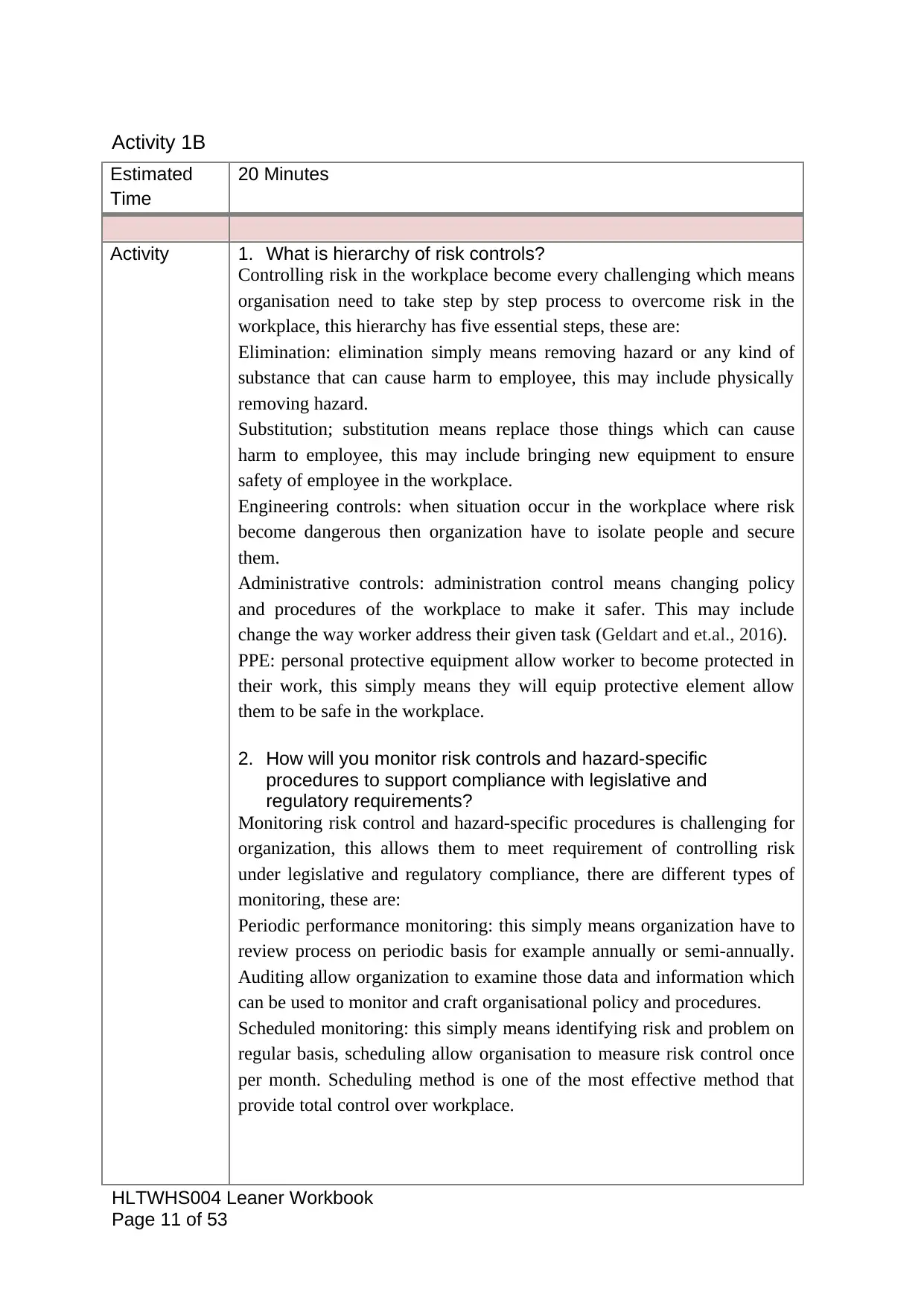
Activity 1B
Estimated
Time
20 Minutes
Activity 1. What is hierarchy of risk controls?
Controlling risk in the workplace become every challenging which means
organisation need to take step by step process to overcome risk in the
workplace, this hierarchy has five essential steps, these are:
Elimination: elimination simply means removing hazard or any kind of
substance that can cause harm to employee, this may include physically
removing hazard.
Substitution; substitution means replace those things which can cause
harm to employee, this may include bringing new equipment to ensure
safety of employee in the workplace.
Engineering controls: when situation occur in the workplace where risk
become dangerous then organization have to isolate people and secure
them.
Administrative controls: administration control means changing policy
and procedures of the workplace to make it safer. This may include
change the way worker address their given task (Geldart and et.al., 2016).
PPE: personal protective equipment allow worker to become protected in
their work, this simply means they will equip protective element allow
them to be safe in the workplace.
2. How will you monitor risk controls and hazard-specific
procedures to support compliance with legislative and
regulatory requirements?
Monitoring risk control and hazard-specific procedures is challenging for
organization, this allows them to meet requirement of controlling risk
under legislative and regulatory compliance, there are different types of
monitoring, these are:
Periodic performance monitoring: this simply means organization have to
review process on periodic basis for example annually or semi-annually.
Auditing allow organization to examine those data and information which
can be used to monitor and craft organisational policy and procedures.
Scheduled monitoring: this simply means identifying risk and problem on
regular basis, scheduling allow organisation to measure risk control once
per month. Scheduling method is one of the most effective method that
provide total control over workplace.
HLTWHS004 Leaner Workbook
Page 11 of 53
Estimated
Time
20 Minutes
Activity 1. What is hierarchy of risk controls?
Controlling risk in the workplace become every challenging which means
organisation need to take step by step process to overcome risk in the
workplace, this hierarchy has five essential steps, these are:
Elimination: elimination simply means removing hazard or any kind of
substance that can cause harm to employee, this may include physically
removing hazard.
Substitution; substitution means replace those things which can cause
harm to employee, this may include bringing new equipment to ensure
safety of employee in the workplace.
Engineering controls: when situation occur in the workplace where risk
become dangerous then organization have to isolate people and secure
them.
Administrative controls: administration control means changing policy
and procedures of the workplace to make it safer. This may include
change the way worker address their given task (Geldart and et.al., 2016).
PPE: personal protective equipment allow worker to become protected in
their work, this simply means they will equip protective element allow
them to be safe in the workplace.
2. How will you monitor risk controls and hazard-specific
procedures to support compliance with legislative and
regulatory requirements?
Monitoring risk control and hazard-specific procedures is challenging for
organization, this allows them to meet requirement of controlling risk
under legislative and regulatory compliance, there are different types of
monitoring, these are:
Periodic performance monitoring: this simply means organization have to
review process on periodic basis for example annually or semi-annually.
Auditing allow organization to examine those data and information which
can be used to monitor and craft organisational policy and procedures.
Scheduled monitoring: this simply means identifying risk and problem on
regular basis, scheduling allow organisation to measure risk control once
per month. Scheduling method is one of the most effective method that
provide total control over workplace.
HLTWHS004 Leaner Workbook
Page 11 of 53
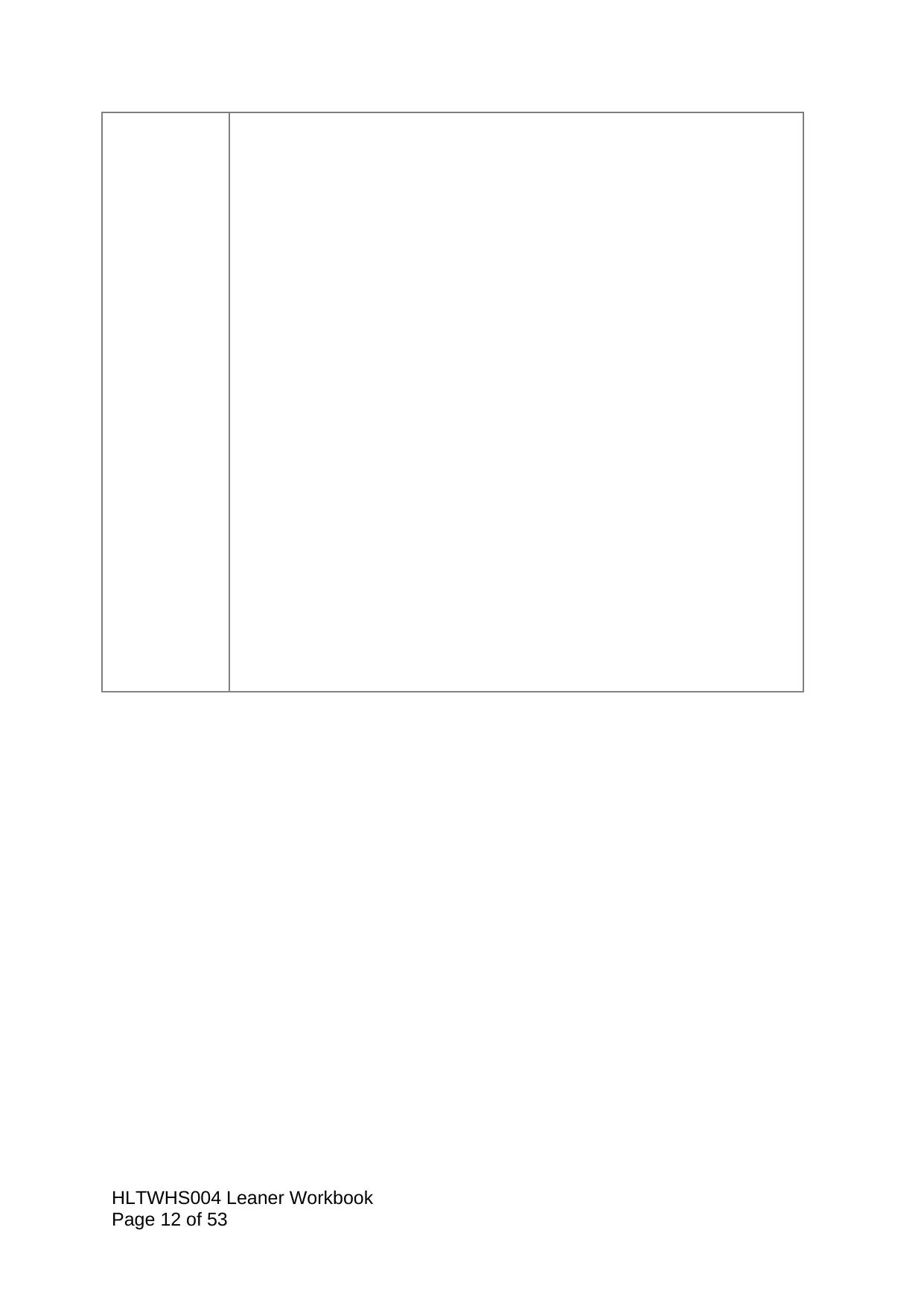
HLTWHS004 Leaner Workbook
Page 12 of 53
Page 12 of 53
⊘ This is a preview!⊘
Do you want full access?
Subscribe today to unlock all pages.

Trusted by 1+ million students worldwide
1 out of 53
Related Documents
Your All-in-One AI-Powered Toolkit for Academic Success.
+13062052269
info@desklib.com
Available 24*7 on WhatsApp / Email
![[object Object]](/_next/static/media/star-bottom.7253800d.svg)
Unlock your academic potential
Copyright © 2020–2025 A2Z Services. All Rights Reserved. Developed and managed by ZUCOL.





